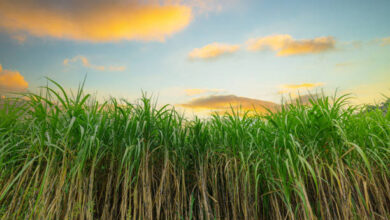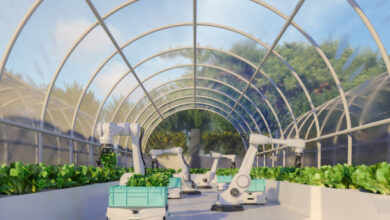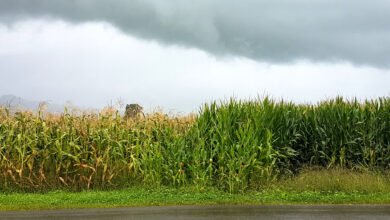
As the world’s population continues to skyrocket, so does our need for a consistent and sustainable food supply. Despite advances in technology, agriculture—the ancient practice of cultivating plants and rearing animals for food—still serves as the bedrock of our sustenance. Central to the success of this endeavor is a silent, often taken for granted provider: rain. In this post, we’re going to delve into how rain shapes and supports agriculture, and how shifts in our climate could have profound impacts on this delicate relationship.
Understanding The Relationship Between Rain and Agriculture
Delving deeper into the vital role rain plays in agriculture requires us to first grasp the fundamentals of plant growth. Consider plants as nature’s perfect chefs. They whip up their own food through photosynthesis – a delicate recipe requiring a perfect mix of sunlight, carbon dioxide, and water. Enter rain, the unsung hero, delivering the key ingredient of water that turns the photosynthesis process into a thriving reality.
In regions where the clouds are less generous, farming transforms into a more complex endeavor. Here, a lack of rain necessitates the use of irrigation systems. While these systems indeed provide a solution, they also carry a baggage of environmental impacts that could potentially offset their benefits. This underscores the invaluable role of rain in agriculture – providing necessary hydration to crops without the accompanying environmental cost that artificial irrigation systems often impose.
As we journey through this understanding, it becomes crystal clear that rain isn’t just a weather phenomenon – it’s the lifeblood of agriculture, the catalyst for plant growth, and the silent, yet indispensable partner in the age-old practice of farming.
Rainfall Patterns and Agricultural Productivity
When you think about farming, one of the first things that might come to mind is the farmer’s keen eye on the sky, awaiting those vital drops of rain. Their entire livelihood hinges on these rainfall patterns that dictate the rhythm of planting and harvesting. When the skies open up generously during the planting phase, the seeds find an ideal environment to germinate and jumpstart their growth. It’s akin to a well-timed starter’s gun at the beginning of a race, setting the stage for a bountiful yield.
On the flip side, a heavy downpour during the harvest period is a farmer’s worst nightmare. Rather than benefiting the crops, an excessive deluge could trigger the onset of diseases or cause the ripe produce to rot right there on the stalks.
The relationship between rainfall and farming isn’t simply a matter of more equals better. It’s a delicate dance requiring just the right amount of rain at the right time to maintain optimum agricultural productivity. So, it’s not hard to see how drastic alterations in the usual rhythm of rainfall could throw a wrench in the entire production cycle, seriously affecting crop yields.
While rainfall has its pros and cons, it’s undeniably a critical player in the agriculture game. That said, it’s not the only element that matters. Factors like soil health, sustainable farming practices, and the looming threat of climate change can also dramatically influence agricultural productivity. These topics warrant their own in-depth discussions which we will explore in the following sections. So, stay tuned to understand how these pieces of the agricultural puzzle fit together.

The Impact of Rain on Soil Health
Rain doesn’t just quench the thirst of crops, it also plays a significant part in shaping the soil’s well-being—a paramount factor in successful agriculture. Think of rain as the conductor of the soil’s nutrient symphony. As it soaks the ground, it dissolves the compounds on the surface and carefully carries them to deeper layers where roots eagerly await their nourishing payload. In essence, rain facilitates a vital nutrient transfer process that fortifies the soil and ultimately, the crops it nurtures.
But as with most things in life, it’s all about balance. While the right amount of rain blesses the soil with nutrient distribution, a deluge of precipitation can quickly turn into a curse. Excessive rainfall can lead to soil erosion, a rather troublesome scenario where the topsoil, along with its stash of essential nutrients, gets washed away. It doesn’t stop there; a torrential downpour can also disrupt the soil structure, leaving it less hospitable for plant roots. This dual threat underscores the precarious tightrope that agriculture walks with rainfall—straddling the line between beneficial nourishment and destructive excess.
It’s a delicate balance, but one that underscores the pivotal role rain plays in both the nurturing and the potential degradation of our agricultural landscape. As we further explore the intricacies of sustainable farming in upcoming sections, this essential role of rain in maintaining soil health will continue to be a theme that resurfaces time and again. This narrative serves as a testament to the crucial, yet often overlooked, relationship between rain, soil health, and agricultural success.
Rain as a Tool for Sustainable Farming
Harnessing the power of rain for sustainable farming is becoming a common trend among growers worldwide. The technique at the heart of this trend? Rainwater harvesting. This age-old practice, which involves capturing, storing, and repurposing rainwater on-site, is garnering renewed interest. By making full use of this natural resource, farmers are able to conserve water, a step that not only promotes sustainability but also reduces the dependency on artificial irrigation methods.
Artificial irrigation, while a useful tool in arid regions, can result in over-extraction of groundwater and an increase in soil salinity levels, creating long-term sustainability issues. By contrast, rainwater, when effectively harvested and managed, can serve as a more environmentally friendly irrigation source, playing a crucial role in conserving our planet’s finite water resources.
But the benefits don’t stop at water conservation. Properly utilized, rainwater can also enhance biodiversity, contributing to a healthier ecosystem within the farm. When different species of plants, insects, and microorganisms thrive, it creates a natural balance that supports overall crop health and resilience, further amplifying the benefits of sustainable farming.
Furthermore, efficient rainwater management can serve as a bulwark against the effects of extreme weather events, such as droughts and floods. Stored rainwater can provide a life-saving source of hydration for crops during prolonged dry spells, while well-designed water catchment systems can help control runoff during heavy rains, protecting the soil from erosion and nutrient loss.
In essence, the rain’s role extends beyond being a simple water supplier; it’s a multi-faceted tool in the sustainable farming toolbox. By harnessing its potential, farmers can cultivate crops in a way that’s harmonious with the environment, preserving our precious ecosystems for generations to come.

The Implication of Climate Change on Rain-Fed Agriculture
As we gaze into the shifting lens of our global climate, the stakes become considerably higher for rain-fed agriculture. The escalating temperatures brought on by climate change aren’t just making our summers more sweltering; they’re disrupting the orchestration of rainfall patterns. What used to be dependable and predictable is now transforming into a weather rollercoaster, fraught with periods of bone-dry droughts and extreme deluges, each with its unique set of challenges for the farming community.
Geography, once a reliable ally for rainfall prediction, may also be betraying its trust under the influence of climate change. Rain may gradually cease to fall on traditionally fertile agricultural lands while starting to bless areas that previously knew only dryness. These geographical shifts in rainfall patterns could potentially upend the established agricultural dynamics, posing a significant risk to global food security.
Such radical changes, stirred up by climate change, are pushing farmers into uncharted territories. They must now navigate a labyrinth of uncertainty, playing a guessing game with the weather, and continually adapting their farming practices to an ever-shifting climate. It’s a harsh reality, indeed, but also a clarion call for resilience.
As we stare into the face of climate change, it becomes clear that our agricultural future hangs in the balance. Our survival in this changed landscape will rely heavily on our ability to adapt, innovate, and find sustainable solutions to weather the storm that climate change brings. Whether it’s through developing drought-resistant crop varieties or devising efficient water management systems, the future of rain-fed agriculture, and by extension, our food security, hinges on our capacity to adapt to a changing climate. This thought-provoking reality underscores the urgency for actionable steps towards climate resilience in the world of agriculture.






I am perpetually thought about this, regards for posting.
I was just seeking this information for a while. After six hours of continuous Googleing, at last I got it in your site. I wonder what is the lack of Google strategy that don’t rank this type of informative sites in top of the list. Normally the top websites are full of garbage.
you have a great blog here! would you like to make some invite posts on my blog?
It?¦s actually a cool and helpful piece of info. I?¦m satisfied that you simply shared this helpful information with us. Please stay us informed like this. Thanks for sharing.
Hello.This article was extremely fascinating, especially since I was looking for thoughts on this issue last couple of days.
When I originally commented I clicked the “Notify me when new comments are added” checkbox and now each time a comment is added I get several e-mails with the same comment. Is there any way you can remove me from that service? Bless you!
You are a very smart individual!
Hi, I think your website might be having browser compatibility issues. When I look at your blog site in Ie, it looks fine but when opening in Internet Explorer, it has some overlapping. I just wanted to give you a quick heads up! Other then that, terrific blog!
Hi there! This post couldn’t be written any better! Reading through this post reminds me of my previous room mate! He always kept talking about this. I will forward this article to him. Pretty sure he will have a good read. Thank you for sharing!
Wohh precisely what I was searching for, thanks for posting.
What Is ZenCortex? ZenCortex is an ear health booster that protects ears from potential damage and improves your hearing health.
Generally I do not read post on blogs, however I wish to say that this write-up very forced me to try and do it! Your writing taste has been surprised me. Thanks, quite great article.
I am often to blogging and i really appreciate your content. The article has really peaks my interest. I am going to bookmark your site and keep checking for new information.
Wow, amazing blog layout! How long have you been blogging for? you made blogging look easy. The overall look of your web site is fantastic, let alone the content!
Contact us
info@zarea2it.com